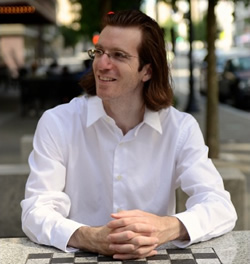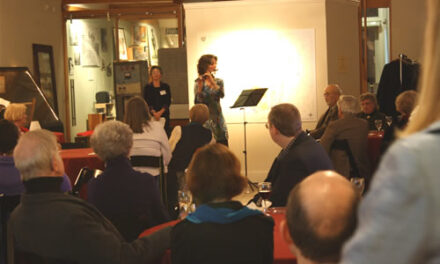When two North Carolina Symphony instrumentalists get together to make music for fun, you can usually expect something magical to happen. Such was the case Thursday evening in the Glenaire Retirement Community‘s auditorium, where assistant principal bassoonist Wenmin Zhang and assistant principal cellist Peng Li collaborated on three large-scale works to showcase a unique combination of two already unique instruments. While the cello is well-known to the orchestra world as the tenor voice of the strings, the bassoon is sometimes overlooked. This large, wooden, double-reed instrument is tall and usually tucked away in the back of the orchestra, where it doubles cello, bass, and sometimes even brass parts, but rarely gets a chance to shine on its own. When it does, it has a huge range and singing timbre that makes it an excellent solo instrument, sometimes even displaying its wit as well.
Zhang’s bassoon playing was energetic, expressive, but did not dominate Li’s sound. They were well-matched, performing on two very different sounding instruments, and their program highlighted these different timbres without clashing. François Devienne’s Bassoon Sonata No. 5 in G minor was first, its three movements serving as an introduction to this duo, but allowing the bassoon to take a solo role. There was just a slight amplification of both instruments to help project the sounds throughout the room but not tamper with the nearly perfect balance and blend these expert players had together. Zhang played with exuberance, slight ornamentation, and vibrato, and even a short, athletic cadenza in the third movement demonstrated his always deft control of his lovely tone.
Mozart’s Sonata for Bassoon and Cello, K.292, is more of a collaborative work, with the cello not replacing the traditional piano accompaniment of a sonata but taking on a persona of its own that engaged in lively dialogue with its counterpart. Li has the crisp precision and subtle expression that Mozart’s compositions always demand, and together he and Zhang drove the piece through delightful surprises: dynamic changes, thematic left turns, and effective uses of silence just to draw out the suspense. The third movement was especially jaunty and fun, with the percussive movement of the cello contrasting with the sonorous flowing notes of the bassoon. Li and Zhang didn’t just have fun playing together; when Zhang paused between movements to remove his reeds for adjustment and blowing the excess condensation out from between them, Li couldn’t resist playfully blowing on the end of his bow, eliciting many giggles from both the performers and the audience.
The last set was a selection of six arias from Gioachino Rossini’s The Barber of Seville, the reduction originally scored for two bassoons, but reworked by these artists for bassoon and cello in a very fun treatment. The bassoon and cello alternated taking over the melodies, and the accompaniment style changed a little each time to suit the idiosyncrasies of the instruments, allowing string crossing and great bowing on the cello and more scale-based quick lines on the bassoon. Although many themes from this opera are well-known (whether from the actual opera or their commercial use by characters like Bugs Bunny!), I only recognized one, arguably the most famous theme, “Largo al Factotum,” characterized by its rapid triplets and sweeping arpeggios. These tunes ranged from sprightly to heavy, delicate to rich, quick to heavily romanticized.
The communication between the players was seamless, and even though they have spent less than a year playing together (and much less than that preparing these particular works – it was intimated by their shy giggles when asked directly about this), they seemed to share an innate understanding of the way they wished their performances to sound. Their rubatos and subtle tempo changes were perfectly in time with each other, and besides one or two slight slips in intonation that were immediately adjusted, they seemed to be in perfect synchrony. Even though they haven’t had many chances to work together outside the NCS, here’s hoping they will share their delightful brand of duos with us more often.












